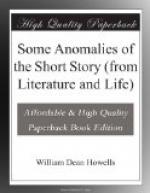The novelette can have almost as perfect form as the novella. In fact, the novel has form in the measure that it approaches the novelette; and some of the most symmetrical modern novels are scarcely more than novelettes, like Tourguenief’s Dmitri Rudine, or his Smoke, or Spring Floods. The Vicar of Wakefield, the father of the modern novel, is scarcely more than a novelette, and I have sometimes fancied, but no doubt vainly, that the ultimated novel might be of the dimensions of Hamlet. If any one should say there was not room in Hamlet for the character and incident requisite in a novel, I should be ready to answer that there seemed a good deal of both in Hamlet.
But no doubt there are other reasons why the novel should not finally be of the length of Hamlet, and I must not let my enthusiasm for the novelette carry me too far, or, rather, bring me up too short. I am disposed to dwell upon it, I suppose, because it has not yet shared the favor which the novella and the novel have enjoyed, and because until somebody invents a way for it to the public it cannot prosper like the one-number story or the serial. I should like to say as my last word for it here that I believe there are many novels which, if stripped of their padding, would turn out to have been all along merely novelettes in disguise.
It does not follow, however, that there are many novelle which, if they were duly padded, would be found novelettes. In that dim, subjective region where the aesthetic origins present themselves almost with the authority of inspirations there is nothing clearer than the difference between the short-story motive and the long-story motive. One, if one is in that line of work, feels instinctively just the size and carrying power of the given motive. Or, if the reader prefers a different figure, the mind which the seed has been dropped into from Somewhere is mystically aware whether the seed is going to grow up a bush or is going to grow up a tree, if left to itself. Of course, the mind to which the seed is intrusted may play it false, and wilfully dwarf the growth, or force it to unnatural dimensions; but the critical observer will easily detect the fact of such treasons. Almost in the first germinal impulse the inventive mind forefeels the ultimate difference and recognizes the essential simplicity or complexity of the motive. There will be a prophetic subdivision into a variety of motives and a multiplication of characters and incidents and situations; or the original motive will be divined indivisible, and there will be a small group of people immediately interested and controlled by a single, or predominant, fact. The uninspired may contend that this is bosh, and I own that something might be said for their contention, but upon the whole I think it is gospel.
The right novel is never a congeries of novelle, as might appear to the uninspired. If it indulges even in episodes, it loses in reality and vitality. It is one stock from which its various branches put out, and form it a living growth identical throughout. The right novella is never a novel cropped back from the size of a tree to a bush, or the branch of a tree stuck into the ground and made to serve for a bush. It is another species, destined by the agencies at work in the realm of unconsciousness to be brought into being of its own kind, and not of another.




